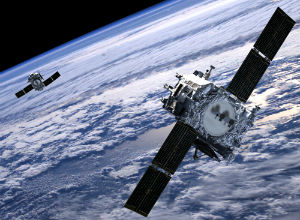Weather forecasts from outer space could help keep Earth safe
17 October 2018

Space weather observations from distant points in the solar system are crucial to improving forecasts of harmful events heading for Earth, new research has shown.
Scientists at the University of Reading have demonstrated how computer simulations that use additional information captured by spacecraft orbiting the Sun can significantly improve the accuracy of forecasts for how solar wind will affect Earth.
Accurate forecasts of space weather are important to warn when Earth could be affected by harmful events like coronal mass ejections (CMEs) – eruptions of hot, magnetised material from the Sun that are dangerous to astronauts, satellites and power systems on Earth.
Mathew Owens, Professor of Space Physics at the University of Reading, said: “This method is already used in weather predictions here on Earth, where data from multiple locations is used to nudge the forecast model back towards reality. Currently, space weather forecasts don’t make use of the available spacecraft measurements of the solar wind, which contain valuable information, even when far from Earth.
“We believe this is the first time this method has been applied to solar wind forecasts, using observations taken by spacecraft many millions of miles away.”
"Data from multiple locations is used to nudge the forecast model back towards reality" - Professor Mathew Owens, University of Reading
The research is published in the Space Weather journal. The scientists used observations of solar wind captured by NASA’s two STEREO spacecraft. They were launched in 2006 and orbit the Sun, one ahead of Earth’s orbit and the other trailing behind. The two spacecraft provide unique measurements of the solar wind conditions far from Earth.
Space weather forecasts are typically made for up to three days ahead. The additional data incorporated into the simulation by the Reading team was shown to significantly improve the forecasts for this period, and future developments of this technique are expected to further extend the useful forecast lead time.
The scientists argue data from yet more spacecraft, such as NASA and ESA missions to Mercury, Venus and Mars, and future spacecraft extremely close to the Sun, should also be used to further understand the solar wind and improve space weather forecasts.
Matthew Lang, co-author of the research at the University of Reading, said: “Our research showed this method improved forecasts by at least 20% in near Earth-space, but we expect that this improvement will be even more significant when used on more advanced models. This method can also be used to incorporate data from the Parker Probe and Solar Orbiter missions into models, enabling us to further understand the physical processes driving the solar wind towards Earth.”
